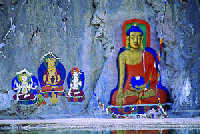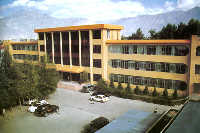|
Initial Formation of Lhasa
( 2005-10-14 )
 During the reign of King Songtsan Gambo in the 7th century, the Potala Palace, the Jokhang Monastery, and the Ramoche Monastery were built. In addition, many small monasteries and palaces were constructed in Lhasa and its surrounding area. During the reign of King Songtsan Gambo in the 7th century, the Potala Palace, the Jokhang Monastery, and the Ramoche Monastery were built. In addition, many small monasteries and palaces were constructed in Lhasa and its surrounding area.
For example, the nine-story Pobengang Palace, where Tubo Minister Tome Sambozha created the Tibetan script and Songtsan Gambo studied Tibetan, was built in the northern suburbs.
In addition, three monasteries were built for Songtsan Gambo's three Tibetan concubines: One of them was built in the Zhayaba Valley in the eastern suburb for Mamsa Trizun; the second monastery was built for Songtsan Gambo's concubine from Zhangzhung by the Tibogor Fountain north of the Jokhang Monastery; and the third monastery was built for Songtsan Gambo's concubine from Moya on the eastern slope of the Tie (Yaowang) Mountain, where the Pharla Lhufo Cave Temple still exists today.
Around the Jokhang and Ramoche Monasteries, Songtsan Gambo built the Prince of Dharma Palace, the Monastery for the Master, military barracks, official residences, civilian housing, and stores. Dams were erected along the Gyiqoi Lhasa River to prevent flooding. Silk and fur markets popped up between the Jokhang and Ramoche Monasteries. At that time, people took ritual walks around the Jokhang Monastery.
According to the law enacted by Songtsan Gambo, Tubo was divided into several administrative divisions ruled by various princes. The Tubo King presided over exchanges with the outside world. Under the tsampo (king) were installed five business departments in charge of trade in tea, jade, knives, silks, and salt, and six crafts departments in charge of making iron objects, saddles, bows, swords, helmets, and Buddha statues. These departments played an important role in stimulating the rise of the city of Lhasa.
Unfortunately, Lhasa did not continue its fast expansion after the deaths of Songtsan Gambo and two of his concubines, Princess Wencheng of the Tang Dynasty (618-907) and the Nepalese Princess Khridzun.
As the Tibetans love tea, the 4th Tubo King, Dorsum Mombogyai (676-740), introduced tea and ceramics from China's hinterland. As a result, the tea trade held an important position in the Lhasa market. Upon death of King Dorsum, his son Tride Zhotsan (704-754) became the Tubo King and married Tang Dynasty Princess Jincheng, another grand event in the history of friendship between the Tang Dynasty and the Tubo Kingdom.
Princess Jincheng brought the statue of Sakyamuni, which Princess Wencheng had brought to Tubo, to the Jokhang Monastery, where it was enshrined in the Main Hall. A whole set of rituals were formed for people to worship the statue. Also during this time, three white dagobas were built under the name of Bagagarling between the Red Hill and the Yaowang Mountain, forming the major entrance to Lhasa.
Lhasa was originally called Gyaixoi Wotang. When the Jokhang Monastery was built, the monastery was named Rosa (the Goats Temple) in memory of the goats that had carried clay to fill up the lake for the monastery's construction.
 When Princess Jincheng brought the statue of Sakyamuni from the Ramoche Monastery to the Jokhang Monastery, the Jokhang Monastery became the worshipping center. Because of this development, Rosa was renamed Lhasa, meaning "Holy Land of Buddha." When Princess Jincheng brought the statue of Sakyamuni from the Ramoche Monastery to the Jokhang Monastery, the Jokhang Monastery became the worshipping center. Because of this development, Rosa was renamed Lhasa, meaning "Holy Land of Buddha."
The name "Lhasa" didn't make its debut in Tibetan classics until 806, when the Tubo King Tride Songtsan erected the "Tablet to the Geqoin Monastery.'' The tablet's inscriptions read: "During the life of His Holy Tsampo Songtsan, Buddhist doctrines were spread and the Jokhang Monastery was built in Lhasa." So "Lhasa" has been in use for almost 1,200 years.
|

